 Tank of the Month
Tank of the Month
Tank of the Month
Amir Spivak's (damura) Reef Aquarium
 |
Introduction
I will never forget the first time I saw the Tank of the Month (TOTM) in Reefkeeping Magazine. I was absolutely amazed by the vitality, colours, and diversity. What I didn’t realize back in 2004 was the huge progress that this hobby would undergo over the following years. Showcasing such reef aquariums serves a very important role in raising awareness for the conservation of such delicate creatures. TOTM creates phenomenal exposure as people around the world, that would otherwise not be able to see reef creatures, can view it. I do think that such exposure will help promote the global interest in coral reefs conservation.
In relation to nature preservation, I want to use this opportunity to approach all hobbyists and ask them to strive for greater conservative efforts in reef keeping. During the past 16 years in the saltwater hobby I have sadly witnessed many unnecessary animal deaths both in my own tank as a beginner and also from many stories I have heard of during these years. Some of this is created by the combination of greedy shops and inexperienced hobbyists being taken advantage of. Some are from hobbyists who are persistent and continue to repurchase a specific animal that cannot thrive in their aquarium, even after multiple attempts. I think that advanced and experienced hobbyists should do their best to aid in preventing unnecessary and basic mistakes by trying to educate the less experienced.
On a more personal note, I want to say how overwhelmed I was when Brian contacted me and told me my tank had been nominated for the TOTM. This is a real dream come true for me. When my friend Chingchai told me that my tank is TOTM stuff I didn’t take it seriously, and didn’t feel ready to post it. I guess I was waiting for the right moment that it would be mature enough to post and it seems that time has finally come!
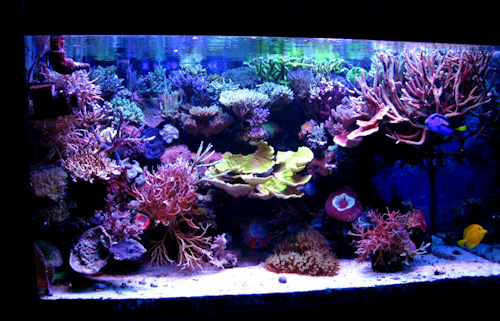 |
The Beginning
I live in Tel-Aviv, Israel and luckily have the opportunity to regularly travel to the Red Sea, which is not too far. Since I was a kid I was intrigued by sea creatures, and whenever my family travelled to the Sinai Peninsula during the Jewish holiday seasons I had the opportunity to see these creatures. Back in those days the Sinai and Eilat reefs were still spotless and untouched. I remember schools of fish surrounding us and coming to eat from our hands whenever we entered the water, especially at Eilat’s famous Coral Beach. Today such a scenario would not happen due to two reasons. First of all, the number of fish has dropped dramatically. Second, nowadays the government protects these animals and prohibits feeding the fish among many other limitations aimed at protecting what is left of this natural gem.
I built the current tank exactly 5 years ago after my wife Einav and I moved into our new apartment. The apartment is quite small for such a relatively big tank making it difficult as I had so many restrictions. I would love to have a separate service room behind the tank where I could place a nice sized refugium and a frag tank. Currently, I settled for a very packed cabinet below the tank. During the renovation of the apartment I ran all the necessary tubing to the RO & DI unit and to the chiller under the floor.
Unfortunately, because of the big renovation undertaken just before I built my tank, I was limited financially when it came to building the aquarium. This led me to cut many corners in terms of equipment. Ultimately this was found to be a big mistake. I struggled with high nutrient and algae problems for more than a year due to a lack of flow and a very primitive Do-It-Yourself skimmer that I bought. Within the first two years, I had replaced virtually all of the filtering system, buying a new skimmer, new calcium reactor, and improving flow significantly.
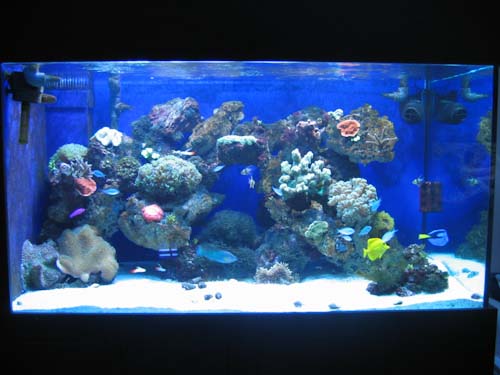 |
Current Tank
As I mentioned earlier my tank went through massive equipment improvements over the first 2 years. Once it was up and running stably I could start populating it with more delicate SPS corals. Luckily, the one thing I did invest heavily in was the aquascaping. Once I got rid of the nutrients and the annoying Bryopsis forest, I could look for nicer and rare SPS corals that fit well into my aquarium. As time passed, I looked for more colour and focused less on fast growth. I found that keeping the colour attractive was the biggest challenge and great growth followed it.
I treat my tank like a Japanese garden. I try to invest as much thought as I can into the placement of corals while taking into account future growth. I aim high when it comes to coral placement and even developed methods to place corals horizontally to get a more natural look. I used a combination of epoxy and super glue gel to attach the corals firmly to the rock. I do this process quickly and one will not find a coral sitting on the gravel for more than one day after arrival to the tank.
Friends from outside the hobby laugh about my aquarium because they do not understand why I keep so few fish. I must say I am much more interested in invertebrates than in fish and that is why my fish population is quiet small. I don’t have any rare or hard to keep fish. In the future I may try some more difficult additions but the frustration of losing fish from my past deters me.
Two months ago I had an accident when trying to remove one of those nasty Acropora-eating hairy crabs. While separating the crab from the coral, I pushed the coral a little too hard and detached it from the rock. I decided to use this opportunity and placed Chingchai’s amazing red table Acropora in its place. Now I have a beautiful red showpiece right in the middle of the tank! What I learned from this little adventure is that one should inspect your corals carefully for all kinds of hitchhikers before you insert them into the tank.
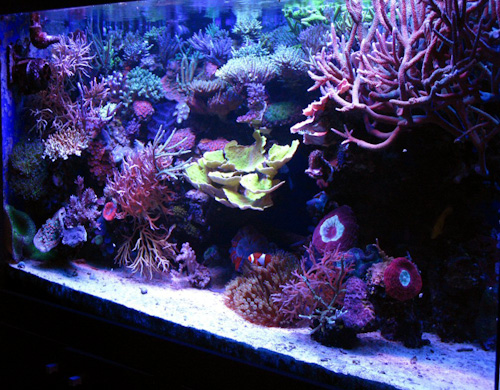 |
System Profile
• Display Tank: 250 gallon (62"x 34"X34")
• Display Lighting: 2x 400 watt 10K BLV Ushio lamps, 2x 400 watt Giesemann ballasts, 2 Giesemann pendant bodies, 2 160 watt URI Super Actinic/454 VHO's, 1 Philips 03 160 watt VHO, 1 KZ 48 watt Fiji purple T5
• Sump: 28" x 24" x 18"
• Return Pump: Sequence reeflo Barracuda
• Calcium Reactor: Schuran jetstream 1 with Grotech media
• Skimmer: H&S 2x 1260 Eheim pumps
• Dosing Controller: Grotech III with extension module EP IV.
• Other Equipment: Carbon and PO4 TLF reactor with Rowaphos media and KZ carbon, 5 stage RO/DI unit and a DIY kalkwasser mixer
Filtration
I divide the reef aquarium hobbyists into two extremes. There are those in this hobby for the equipment, replacing it all the time, exchanging technical parameters and capacities like car enthusiasts. At the other end are those who are here for the animals and relate to equipment only as a means to keep them happy. Of course I am describing the two ends and most of us are somewhere in between. I place myself close to the animal side of the spectrum. Once I bought my skimmer and reactor I never touched my filtration machinery again. I hadn’t even bothered checking what's new on the market.
At some point during my web surfing I bounced into Iwan Lasser’s amazing tank and studied it carefully. I was very surprised to find out that he was using deep sand bed (DSB) when everyone around me was talking about bare bottoms. From what I had seen it seemed to me that DSB was an obsolete method. Then I checked the popularity of DSB with European hobbyists and found out that many use it with great success. Personally, I was still deterred by horrible stories about poisonous sulphide gases hidden within the gravel that would emerge one day killing all tank inhabitants. Further research brought me to purchase Ron Shimek’s book "Sand Bed Secrets" that deals with DSB systems and reached the conclusion that these horrible stories are mostly urban legends.
When I decided to do a DSB on my aquarium I did make sure that my Tunze internal pumps were mounted securely into the glass panes to prevent their detachment and colossal sand storms within the tank, which would definitely release pungent gasses in high levels. The DSB did reduce my nitrate levels due to anaerobic regions within and helped to promote my micro fauna community. One other thing I was testing was using a small refugium, which I had built in my sump. I had received Chaetomorpha algae from a friend and placed a PL lamp overtop, so that my cabinet would not overheat, but I eventually gave up on the refugium. I didn’t see any significant algae growth, which leads me to the conclusion that it was not effective. I heard that Chaetomorpha grows very fast when using metal halide bulbs. In the future I plan on experimenting again with Chaetomorpha, when I will have enough space for a proper refugium.
Water Circulation & Flow
I have two sources of flow that combine together for an approximate flow rate of 11,000 gallons per hour or a turnover of about 45 times per hour. The main pump is a Sequence Reeflo Barracuda with a flow rate of 4500 gph, and for internal flow i use two Tunze 6100 Turbelle pumps, each with a flow rate of 3000 gph controlled by a 7095 controller. My chiller is fed by a pipe that runs under the floor and is fed by the main pump, the angles i used in this pipe are 45 degrees to enable a better flow.
|
Water Parameters:
|
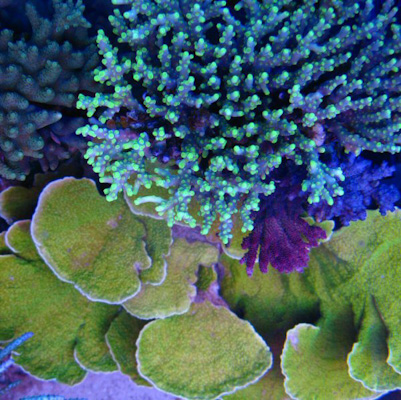 |
Lighting
Lighting was something I have played around with a lot. Reaching the right appearance and coral colours took a great deal of trial and error. I was experimenting with a few brands of 400 Watt Metal Halide lamps, eventually I was satisfied with the BLV Ushio 14,000 Kelvin, but decided to change them after 2 years to the 10,000 Kelvin ones after I heard stories of better growth and nicer red/yellow colours. This last change was found to be a mistake and when the next lamps need replacement I will return to using the 14,000 Kelvin lamps which have amazing bright white colour. Another change my lighting went through was adding more and more VHO lamps to the system. First I added a Philips T12 actinic lamp that was once very popular in Israel. Last year when UVL were introduced to Israel by an importer who is a friend of mine I bought a double fixture with 2 lamps, a 454 and a super actinic. Ultimately I have reduced the MH operation to 6 hours a day and am very pleased with the fluorescent-only overall look. I do have to change my old ballasts to electronic ones to cut on the electric bills.
Maintenance, Feeding & Supplements
When I talk to people at work or friends that do not keep an aquarium, one of the first things I am asked is how much daily work I invest in my tank. They imagine the hobby is mostly of running with buckets in the house or drawing water from hoses with their mouths. I find myself explaining two things to them. First of all most of the work is done automatically nowadays. Second, and most importantly, if you do not enjoy maintaining your tank you are definitely in the wrong hobby. The difference between a well kept tank and a run down one can be as simple as a lack of routine and proper maintenance. Hobbyists sometimes tend to forget that the most important thing for coral health is stability. When one starts to cut corners such as skipping salinity tests, postponing filter media replacements, the corals will quickly notice this and reduce in coloration.
I keep a log book to record all the routine jobs I have to do. I clean the skimmer once a week, replacing KZ carbon once a month, and do not let the calcium media in the reactor drop to less than half of the column. I add Kalkwasser twice a week and feed the fishes automatically twice a day. I also measure phosphate with the Hanna small digital meter and change the media whenever necessary. I keep a total of 400 ml of Rowaphos media in the reactor.
Although I have nice flow inside the tank, there are still many dead spots where detritus settles. I use a very strong power head once a week to wash my plate corals and parts of the rocks where this detritus settles. It is amazing to see that even in very poor nutrient environments, when you have detritus on the rock present, how Cyanobacteria will immediately begin to flourish. A better flow regime can minimize this annoying phenomenon significantly.
I pay close attention to coral pruning to prevent corals from overshadowing or coming in contact and burning each other. Even with such close attention I have had some unfortunate cases. For example my mushrooms stung my Australian Scolymia and in a very upsetting case one of my Echinoporas stung my Bleeding Apple Scolymia almost killing it when I was travelling abroad.
When it comes to supplements, like many of us I am afraid I still didn’t reach a concrete conclusion. I worked with several companies and didn't see significant changes. I think that many hobbyists add too much supplements therefore reducing coloration. As a rule of the thumb I use the "less is better than more" approach. Today I use a little of the Red Sea Coloration supplements and do a 25% water changes once a month. I do find the KZ AAHC and KZ coral vitalizer products help with better polyp extension and coloration. I use to add VSV but stopped a year ago when I did not detect a difference. Though I feel I must add that initially the only thing that killed my Bryopsis forest was Vodka addition, it worked like a miracle back then.
Livestock
I keep about 20 fishes from the following species:
|
 |
Corals
In terms of corals, my tank is dominated by about 50 different SPSs. I once tried to identify them but after I bought Veron’s corals of the world reference book. I reached the conclusion that most of them are very hard to distinguish so I abandoned it altogether. There are a few species which I can easily identify:
|
Acropora:
|
Montipora sp. LPS |
 |
 |
 |
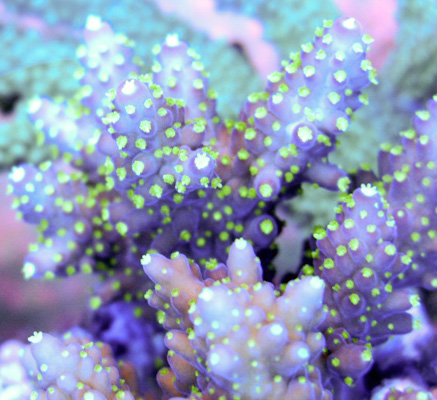 |
Acknowledgements
First and most importantly I want to thank Einav, my beloved wife, for her tolerance and understanding of this obsession that I have. I can’t count the amount of times we went off route during our trips in the world to meet a hobbyist or to visit a remote aquarium shop. It is amazing to see my little son, Tomer growing up with this tank and developing such a strong affection for all sea creatures (apart from the scary shark of course).
I want to thank Chingchai for his amazing hospitality whenever I visit Bangkok; he was and still is a great inspiration for me when it comes to professionalism and perfectionism. I also want to thank all his friends from the amazing Siam Reef club. Hope to see you soon around the JJ Plaza.
 |
I want to thank my Israeli friends who are addicted with the same obsession:
Yacov, who helped me with the piping, built my chiller, and built my Kalkwasser mixer. The Zoanthid fanatic, Gili, from ReefXL. Yitzhaki from Aquatix who helped me with the lighting and the design of my new tank, and Moshiko, the owner of a huge and amazing reef tank.
Last but not least I want to thank Fresh Reef and its amazing staff, Villi, the best saltwater fish specialist in Israel. He is the person who is responsible for importing most of my amazing tank inhabitants. Meir, Matan, Baruch, Haim, Dudy, and all the rest of the great Fresh Reef team who shared with me so many sleepless nights unpacking loads of fish and corals from around the world.
Feel free to comment or ask questions about my tank in the Tank of the Month thread on Reef Central.



